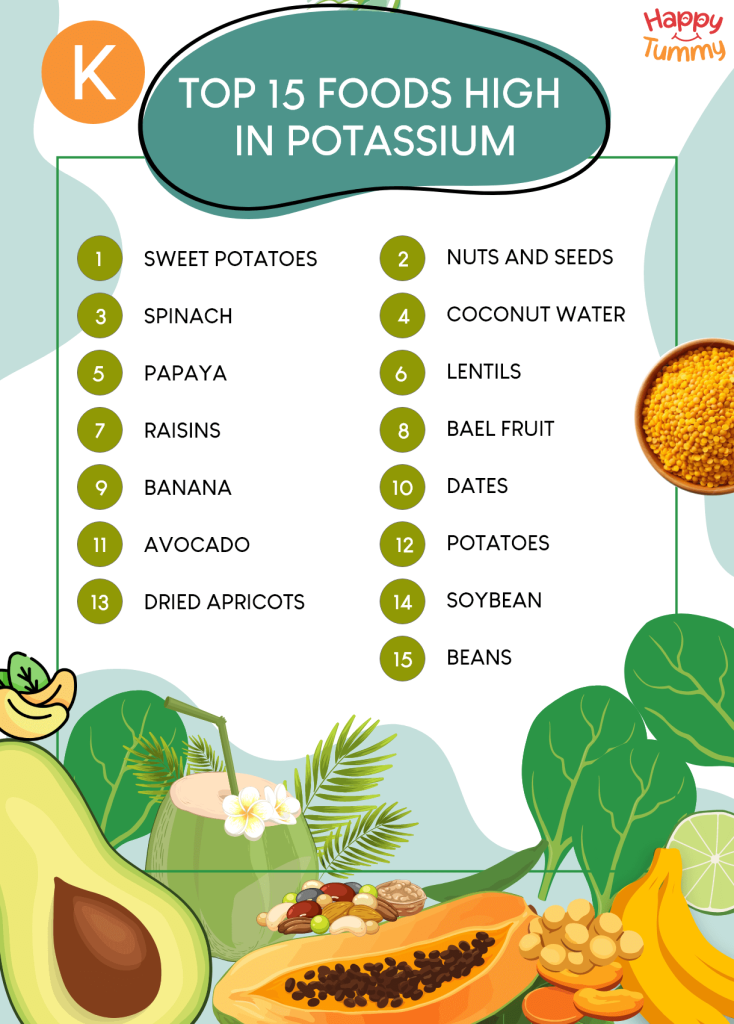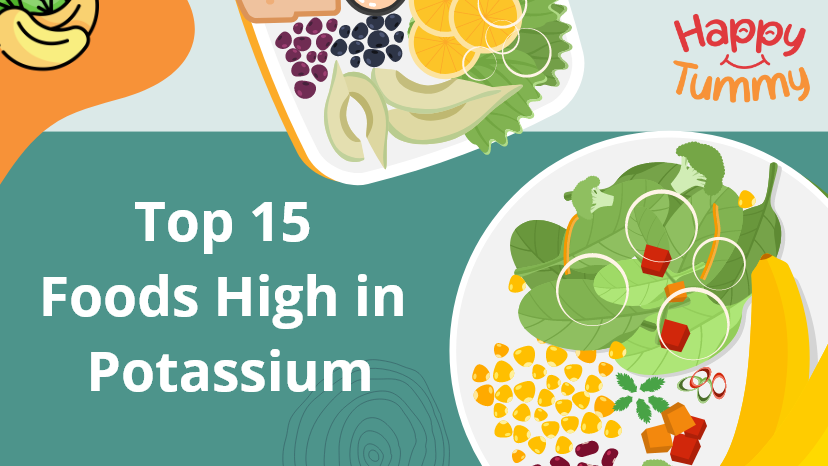Table of Contents
Potassium flies under the radar. It is a mineral that most people don’t think much about outside of scientists, athletes, and those with high blood pressure. You probably last heard about potassium when studying the periodic table in chemistry class, where the symbol K stands for it.
If they consider it at all, many don’t give this underappreciated mineral any thought. That being said, you might not be getting nearly enough of these crucial nutrients.
For general wellness, it’s a good idea to concentrate on including foods high in potassium in our meals. We consume potassium from a variety of foods, mainly fruits and vegetables. This blog will discuss foods high in potassium that benefit general health and well-being.
Foods That Are High in Potassium
Potassium is an essential element that helps maintain healthy circulatory function, facilitates muscular contraction, and controls bodily fluid balance. Numerous nutritious foods can provide abundant amounts of this vital nutrient.
Below is the list of the top 15 items high in potassium.

#1 Beans
Kidney, black, and broad beans are rich in potassium, and may aid in managing blood pressure by maintaining sodium balance in the body. [1]They may also manage blood pressure by relaxing blood vessel walls. [2] Beans also include fibre and protein. They go well with bean salads, tacos, stews, and more.
#2 Sweet Potatoes
Sweet potatoes are a wholesome items to supplement your potassium intake. In addition, they provide protein, are low in fat, high in fibre, complex carbohydrates, and vitamin A. Potassium-rich products may help to maintain a healthy cardiovascular system. [3]
You may combine these tasty root vegetables with meat, beans, or dark green veggies for a satisfying and well-balanced dinner. Try mashing sweet potatoes or add them roasted or sauteed to meals.
# 3 Nuts and Seeds
Most nuts and seeds are excellent in potassium, iron, zinc, copper, and magnesium. Potassium-rich diets can counteract some of the adverse effects of salt, thereby managing blood pressure. Unsalted nuts and seeds can help lower your sodium consumption. [4]
High-potassium nuts and seeds include sunflower, pistachios, walnuts, flax, and watermelon seeds.
#4 Spinach
Most of the green leafy vegetables contain a good amount of potassium; however spinach/ Palak contains high amount of potassium 625mg. It also has high folate, magnesium, vitamin K, vitamin A, and other nutrients.
You may add raw spinach to sandwiches and salads. You may quickly steam frozen spinach or add it to soups or parathas.
#5 Coconut Water
The transparent liquid within fresh coconuts is called coconut water. As the coconut ages, the water is replaced by coconut flesh.
Furthermore, because coconut water contains more potassium than sodium, the potassium may help neutralise and even lessen the effects of sodium on blood pressure. Particularly when exercising, potassium helps maintain fluid & electrolyte balance as well as the PH level in the body. [5]
# 6 Avocados
Avocados are thick, creamy fruits high in potassium, which may support nerve transmission, fluid and mineral balance, and muscular contraction. Additionally, potassium could be necessary for healthy kidney and cardiac function. [6]
Avocados also contain vitamin K, folate, and healthy fats. Because of their smooth texture, they are versatile and fit for sandwiches, salads, and even dips.
#7 Papaya
The papaya is a healthy, tropical fruit that is incredibly nutritious. Its abundant antioxidants may help fight disease, lessen inflammation, and improves your digestive system.
In addition, this golden delight is an excellent source of potassium, calcium, and vitamins A and B. Papaya may lower uric acid and aid in the kidneys’ detoxification. [7]
#8 Lentils
Lentils and beans belong to the same family and have rich potassium content. In addition, lentils provide iron, protein, fibre, and folate. Legumes high in potassium include moong dal, channa dal, and tur dal.
Red, brown, green, and black lentils work well in Indian dals, soups, stews, and salads.
#9 Raisins
Raisins have several health advantages and may aid in managing blood pressure. They assist with a crucial electrolyte in heart rate control and muscular contraction [21].
It may contribute to the body’s regulation of fluid balance. Since potassium is essential for muscle function, eating raisins is beneficial for your health
#10 Bael Fruit
Minerals and nutrients, including calcium, iron, and potassium, are abundant in Bael. These nutrients may be part of why Bael works so well to boost immune function, encourage healthy digestion, and enhance skin and hair health.
The health of the kidneys, liver, and heart may benefit from the high potassium concentration. The high potassium content may aid blood purification, toxin removal, and immune system strengthening. [8]
You can take a two minute Digestive Quotient Test by Aashirvaad to check your digestive score out of 100. It will help you knowing about your digestion, making you more inclined to improve it.
#11 Banana
Bananas are beneficial in maintaining blood pressure and heart health. You can get between 320 and 400 milligrams of potassium from a medium-sized banana, roughly 10% of your daily requirement. [9]
Your body needs potassium to keep its heart and blood pressure in check. Bananas also have lower sodium levels. The combination of high potassium and low sodium may help to regulate hypertension.
#12 Dates
We love dates so much! Dates are a great natural sweetener and a good potassium, fibre, vitamin B6, and copper source.
They make a perfect morning snack because of their natural sugar content, which may provide a quick energy boost. They may prevent calcium loss, thereby helping with bone mineral density.
#13 Potatoes
Potatoes might have a bad reputation but its because how we cook and eat them. Excessive carb content, and the common practice of frying them are responsible!
But there is some good about potatoes. A medium potato with skin on it contains 610 mg of potassium, or 13% of the recommended daily dose. [10]
So don’t fear taters! Just make sure you cook them using healthier methods like roasting and baking instead of frying or smothering them with cheese and butter.
#14 Dried Apricots
Make an effort to look for the dried apricots for a potassium-rich feast. A half-cup of these Mediterranean fruits provides roughly 16% of the daily recommended dose of potassium, making them among the planet’s highest-potassium meals. [11]
For a nutritious snack, eat dried apricots by themselves. Alternatively, pack dates with chopped dried apricots and cream cheese to make dried fruit work double duty.
#15 Soybean
Soybeans and soy-derived foods are good plant-based protein sources, heart-healthy fat, fibre, potassium, iron, and more. One cup of soybeans may contain 886 mg of potassium [12].
Consuming adequate potassium is beneficial to your heart functioning also.
Potassium Content
So, after discussing foods high in potassium, let us check the content to get an idea of how much potassium you are consuming [13].
| Food Item | Potassium Content (per 100 grams) |
| Rajma (Brown Kidney Beans) | 1366 mg [14] |
| Black Rajma (Black Kidney Beans) | 1362 mg[15] |
| French Beans | 324 mg |
| Broad Beans | 362 mg |
| Sweet Potato | 345 mg |
| Walnuts | 457 mg |
| Pistachio Nuts | 1053 mg |
| Sunflower Seeds | 559 mg |
| Spinach | 625 mg |
| Coconut Water | 250 mg[16] |
| Avocado | 377 mg |
| Papaya | 173 mg |
| LentilLentil BrownLentil Whole Yellow | 786 mg [17]756 mg764 mg |
| Raisin dried golden | 913 mg |
| Bael fruit | 409 mg |
| Banana | 362 mg |
| Dates | 804 mg |
| Potato | 541 mg[18] |
| Dried Apricot | 285 mg |
| Soybean BrownSoybean White | 1613 mg[19]1634 mg |
How Much Potassium Do I Need?
As per the ICMR-NIN, the RDA of Potassium for all age groups is 3500mg.
Even though it might sound like a lot, it is possible to reach that goal by eating a varied diet that emphasises whole foods high in potassium, such as fruits, vegetables, beans, and lentils.
The Bottom Line
A person should get adequate potassium if their diet is high in fruits, vegetables, and legumes. Eating fewer high-sodium items, such as processed foods and fast food, can help to balance this.
In addition to helping maintain a healthy potassium level, this dietary strategy may make it easier for people to obtain a range of other vitamins and minerals found in whole foods and support improved health.
Eating a healthy, balanced diet is essential for general health and may help you feel better. A varied diet in the appropriate proportions and balances is vital.
However, if an individual is diagnosed with any kidney ailment such as hyperkalemia, CKD, or AKI or is on dialysis should be cautious while consuming potassium-rich foods and should also follow the leaching method to remove potassium from the foods.
But before you make any big dietary or activity changes, remember to see a qualified dietitian or nutritionist, especially if you have any dietary restrictions or underlying medical concerns.
Contact our certified nutritionist for a 45-minute consultation to plan the best foods high in potassium.
Frequently asked questions
One strategy to increase potassium levels is to eat foods high in potassium, such as kidney beans, avocados, lentils, sweet potatoes, tender coconut water and dried apricots.
It facilitates proper neuron, muscular, and cardiac function and the movement of waste products and nutrients among bodily cells. However, the body’s potassium levels can be hazardous at either high or low levels.
A low potassium level can cause irregular cardiac rhythms as well as weak, cramping, twitching, or even crippling muscles.















